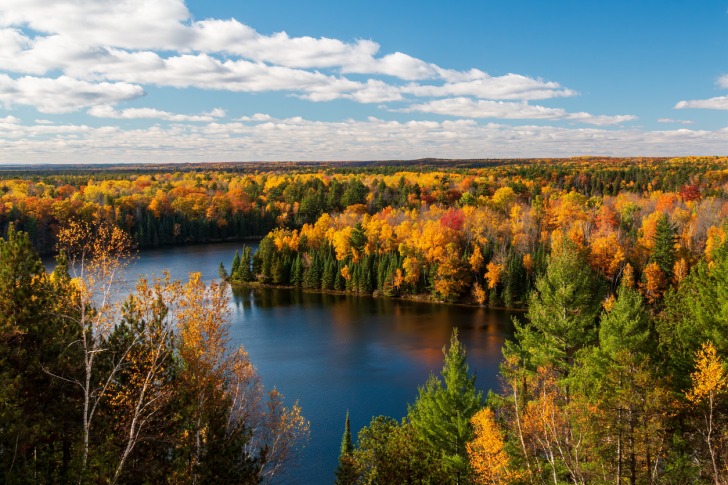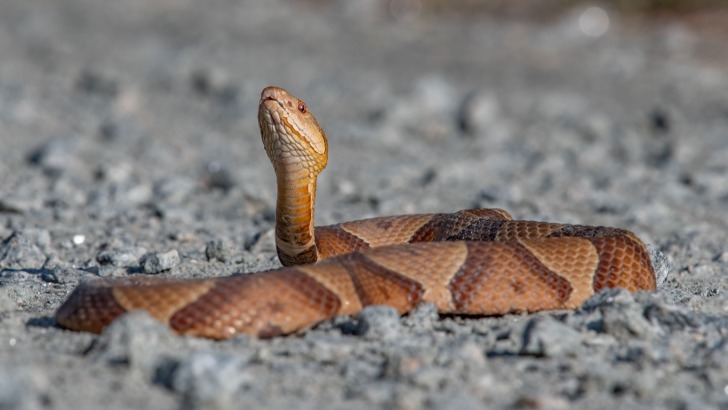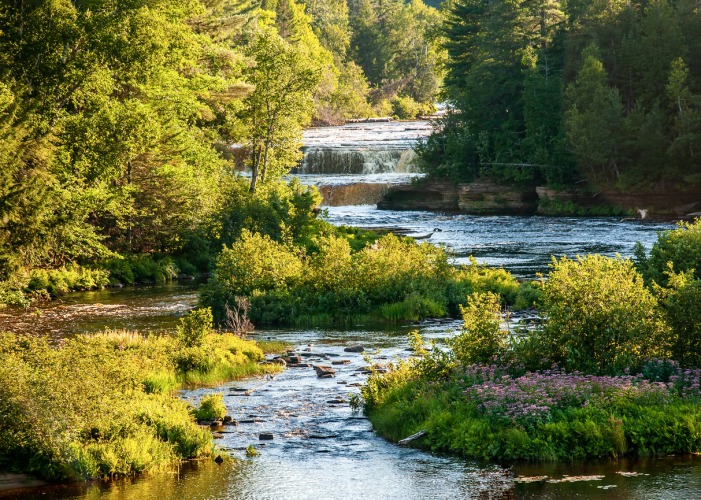Michigan is known for bordering the Great Lakes, but did you know it also has snakes?
The state is home to nearly 18 snake species, one of which is venomous.
Most of Michigan’s snakes live in places you wouldn’t expect.
Snakes can be found in areas near water in Michigan, specifically the marshlands.
With so many wetlands in the state, there are specific areas where you should avoid them.
Specifically, forest habitats, grasslands, lakes, rivers, marshes, etc.
Below, we’ll explain everything you need to know about snakes in Michigan and where you can find them.

Contents
So… Are There Snakes in Michigan?
Yes!
The state has 18 snake species, ranging from nonvenomous to venomous.
Michigan’s climate ranges from warm, humid summers to cold winters.
These are the perfect temperatures for snakes to thrive in.
As you can see, a large population of snakes is inside Michigan.
While most snakes are non-aggressive, some are still venomous snakes.
Michigan’s venomous snake is the Eastern Massasauga rattlesnake.
While it seems intimidating, it’s mainly non-aggressive and hides in the wild.
Michigan’s largest snake is the gray rat snake, known for growing up to eight feet long.
This massive snake can be found in the southern half of the peninsula.
However, there is a declining population, and they are on the Michigan Department of Natural Resources list of species of special concern.
Snake Species in Michigan
The 18 snakes in Michigan include the following:
- Kirtland’s Snake
- Northern Ribbon Snake
- Eastern Hog-Nosed Snake
- Northern Ring-Necked Snake
- Eastern Fox Snake
- Smooth Green Snake
- Queen Snake
- Eastern Milk Snake
- Blue Racer Snake
- Eastern Massasauga
- Northern Water Snake
- Copperbelly Water Snake
- Northern Ribbon
- Black Rat Snake
- Gray Rat Snake
- Brown Snake
- Butler’s Garter Snake
- Eastern Garter Snake
Is it Safe to Go on a Trek in Michigan?
Going on a trek in Michigan is considered a very safe activity.
The mortality rate, according to the National Park Service, is 0.1 deaths per 100,000 visits.
This is significantly low in terms of risk.
You have a higher chance of getting hit by a car in the city than if you are bitten by a snake out in the wild.
The only dangerous snake is the Eastern Massasauga Rattlesnake.
However, the snake is rather timid and doesn’t often show itself to humans.
The only way it will attack is if it feels threatened.
So, Michigan is generally a safe place to trek.
Other snakes can be found in marshes or wetlands.
Yet again, these snakes aren’t hostile unless threatened.
Many Michigan snakes aren’t aggressive and will only initiate hostility if they feel like they are in danger.
Therefore, you won’t have to worry if you’re going on a hike inside Michigan state.
The only way they become dangerous is if you aren’t paying attention.
Interesting Snake Facts in Michigan
Of snakes in Michigan, the Gray Rat Snakes can grow nearly eight feet long!
These massive snakes are found in the southern half of the lower peninsula, where most snakes are located.
They are very rare but are on the decline due to climate change and loss of habitat.
In addition, Michigan does have cold winters.
On average, the state sees winters with a low of 20.
Snakes generally need to be in temperatures that range from 70 to 80 degrees Fahrenheit.
However, some have evolved to survive harsher climates through hibernation.
Snakes in Michigan survive the cold winters by going into hibernation.
All the snakes in Michigan have learned how to hibernate, better known as brumation.
They rest from October until April.
For snakes, this process is called brumation, as hibernation is used for warm-blooded animals.

3 Safety Tips for Exploring Nature in Michigan
Michigan has plenty to give, with its mountainous areas and the Great Lakes.
Some of the most popular destinations for hiking are found in the southern region of the state, near the peninsula.
If you plan to travel there, you must know the dangers outdoors.
Below, we’ll help provide three essential tips to ensure your nature exploration in Michigan is safe.
1. Be Mindful of Surroundings
To be safe while hiking, being mindful of your surroundings is important.
Many of Michigan’s snakes are difficult to spot due to being shy.
They also generally live in forests or near wetlands, surrounded by materials that can camouflage their bodies.
While most of Michigan’s snakes aren’t dangerous, it’s still not recommended to get into a close encounter with a snake.
Snakes that don’t have venom can still cause health complications.
So, it’s best to be prepared and mindful of your surroundings and to avoid areas where they may inhabit.
2. Be Careful Near Water
While Michigan has some stunning lakes and rivers, it’s best to be safe around them.
Some waterfalls and swifts can make the surrounding areas more dangerous to trek.
For example, rocks near waterfalls tend to be wetter and thus can cause hikers to slip.
In addition, crossing streams can be extremely dangerous.
It’s better to find a path and stick to it.
Don’t try and go around or go through the water.
Snakes and other dangerous animals, such as ticks, live in these areas and can cause bodily harm if threatened.
3. Prepare for Bad Weather
Michigan has very finicky weather that can change on a dime.
If you’re looking to explore the outdoors, make sure to check the weather forecast for the trail.
That way, you know what you’re up against.
However, you should be prepared for the worst since the weather can change unexpectedly.
Bring proper clothing, such as waterproof jackets and boots.
In addition, choose rubber-soled hiking boots so you have better traction.
Otherwise, you might be stuck outdoors in the cold without the proper gear.
Summary
Michigan is a fun state to explore, with plenty of places to go trekking.
If you’re interested in snakes, then there are plenty to see.
However, most are found in the state’s southern end.
Luckily, many of the state’s snakes aren’t dangerous.
Many of them are too shy to get involved with humans.
However, that doesn’t mean that there isn’t risk.
That being said, we hope we’ve helped you discover more about snakes and Michigan.
Michigan Safety Overview
READ THE FULL REPORT: Michigan Safety Review
Safety Index:
- OVERALL RISK: LOW
- TRANSPORT & TAXIS RISK: LOW
- PICKPOCKETS RISK: LOW
- NATURAL DISASTERS RISK: LOW
- MUGGING RISK: LOW
- TERRORISM RISK: LOW
- SCAMS RISK: LOW
- WOMEN TRAVELERS RISK: LOW
Frequently Asked Questions
Are snakes common in Michigan?
It is not common in some regions but mainly in the south near the peninsula and Great Lakes.
The most spotted tends to be the northern ribbon snake, but many others appear depending on where you go.
Be sure to look up the surrounding wildlife if you plan to travel to Michigan for hiking.
Do Michigan lakes have snakes?
Michigan’s lakes are full of snakes, as most of them enjoy the cool water.
The most common lake-dwelling snake in the state is the Northern Water Snake.
However, there are a handful of other snakes in Michigan that don’t just survive in the lakes.
Are there any venomous snakes in Michigan?
There is only one venomous snake in Michigan: the eastern Massasauga rattlesnake.
It’s one of two rattlesnake species in the Great Lakes region.
However, it’s very timid and often doesn’t bother with humans, even though it’s classified as dangerous.
However, it’s on a danger list; if you come into contact with one, you should avoid it.











